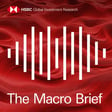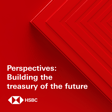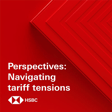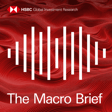Become a Creator today!Start creating today - Share your story with the world!
Start for free
00:00:00
00:00:01

The Macro Viewpoint - US and UK policy rates leap, China’s slow rebound
We assess this week’s hefty transatlantic rate rises and why China’s economic recovery might be more gradual than expected. Disclaimer. To stay connected and to access free to view reports and videos from HSBC Global Research click here
Hosted on Acast. See acast.com/privacy for more information.
Transcript
Introduction to Global Insights Podcast
00:00:01
Speaker
Welcome to HSBC Global Viewpoint, the podcast series that brings together business leaders and industry experts to explore the latest global insights, trends, and opportunities.
00:00:13
Speaker
Make sure you're subscribed to stay up to date with new episodes.
00:00:16
Speaker
Thanks for listening.
00:00:17
Speaker
And now onto today's show.
Economic Policy and China's Economy
00:00:23
Speaker
You're listening to the HSBC Global Research Macro Viewpoint, our weekly review of the key reports from our economists and strategists across the globe.
00:00:35
Speaker
Coming up this week, we assess the path for monetary policy on both sides of the Atlantic, following hefty rate rises by the Fed and the Bank of England.
00:00:45
Speaker
And we look at why China's economic recovery might be more gradual than expected.
00:00:50
Speaker
This podcast was recorded on Thursday, the 22nd of September, 2022.
00:00:54
Speaker
Our full disclosures and disclaimers can be found in the link attached to this podcast.
Ryan Wang on Federal Reserve's Rate Hike
00:01:02
Speaker
Hello, I'm Aline Van Dyne.
00:01:04
Speaker
And I'm Piers Butler coming to you from the US, where this week the Federal Reserve raised policy rates by 75 basis points and reiterated their hawkish outlook for future increases.
00:01:14
Speaker
Let's get the thoughts of Ryan Wang, US economist.
00:01:17
Speaker
Ryan, welcome to the podcast.
00:01:19
Speaker
Thanks, Piers.
00:01:20
Speaker
Pleasure to be here.
00:01:20
Speaker
The FOMC met yesterday and, as anticipated, raised rates by 75 basis points, but the markets clearly didn't like the dots.
00:01:29
Speaker
Can you explain to us what that means?
00:01:31
Speaker
That's right.
00:01:32
Speaker
The FOMC raised the federal funds target range by 75 basic points for the third meeting in a row, but it was those projections that got the attention.
00:01:40
Speaker
The dots are the forecast from the policymakers about what they expect future
00:01:46
Speaker
policy rates to be.
00:01:47
Speaker
And particularly for the end of this year, that's very concrete guidance because there's only two more policy meetings.
00:01:52
Speaker
And essentially, the
Inflation and Labor Market Impact on Rate Hikes
00:01:54
Speaker
median projection of the policymakers is that the Fed funds rate will need to move up by another 125 basis points over the course of those two meetings in November and December.
00:02:04
Speaker
Do you get a sense that the market was more bullish than that in terms of anticipations?
00:02:09
Speaker
Well, this is a function of what's been happening with the economic numbers, particularly on the inflation side.
00:02:14
Speaker
There hasn't been any significant slowdown in the inflation pressures coming through.
00:02:19
Speaker
And this is what's prompting these successive waves of upgrades to policy rate projections and downgrades to the growth outlook and a more pessimistic outlook for inflation.
00:02:32
Speaker
You know, what's going to be key, I think, is what happens to the labor market, which has continued to show strong job creation so far this year.
00:02:39
Speaker
That is one of the factors that's contributing to high and elevated sticky inflation.
00:02:44
Speaker
So
Rate Hike Forecast through February 2023
00:02:45
Speaker
on the back of this, Ryan, you've updated your own forecast.
00:02:47
Speaker
Can you run us through what they are now?
00:02:48
Speaker
So we're expecting continued rate hikes over the next three policy meetings of a larger magnitude than we previously forecasted.
00:02:54
Speaker
So we're looking for a 75 base point rate hike in November, 50 basis points in December, and a final 25 base point rate hike in February of 2023.
00:03:03
Speaker
That would take the federal funds target range up to four and a half to four and three quarters percent.
00:03:08
Speaker
So that forecast is 50 basis points higher than our previously projected peak for Fed funds.
00:03:14
Speaker
And how much confidence do you have in that estimate?
00:03:17
Speaker
In a sense, do you sense we're in an environment where, again, it is a lot of uncertainty regarding these economic forecasts?
00:03:22
Speaker
Or do we feel that we've not got to a sense of where rates are going to peak?
00:03:26
Speaker
Well, what I would point to is not just the inflation numbers, which will be crucial, but also this configuration of labor market data.
00:03:33
Speaker
And so in particular, the Fed thinks that labor market conditions may need to soften for inflation to fall.
00:03:39
Speaker
There's three indicators in particular that I would watch.
00:03:41
Speaker
I'd be looking at the level of job openings, which still remains very, very high.
00:03:45
Speaker
Looking at unemployment, which we do think will be increasing over the course of the next year, and also wage pressures.
00:03:51
Speaker
wage growth is running at a level that the Fed thinks is too high to be consistent with 2% inflation.
00:03:56
Speaker
Ryan, thank you very much for joining us today.
00:03:58
Speaker
Thanks a lot, Piers.
00:04:03
Speaker
So that's the view from the US.
Fed's Labor Market Focus and Inflation Control
00:04:05
Speaker
And in the UK, the Bank of England also delivered a large rate rise this week.
00:04:10
Speaker
This comes ahead of Friday's mini budget from new Chancellor Kwasi Kwarteng aimed at tackling the cost of living crisis.
00:04:18
Speaker
Liz Martens is our senior UK economist.
00:04:21
Speaker
Liz, welcome to the podcast.
00:04:24
Speaker
Thanks very much.
00:04:25
Speaker
So tell us what the Bank of England did.
00:04:28
Speaker
So the Bank of England raised rates by 50 basis points to 2.25%.
00:04:33
Speaker
That's in line with what we and the consensus of economists had expected, but it stopped a bit short of what the market had been pricing, which was a pretty strong chance of a larger 75 basis point move, which of course we've seen from other central banks like the Fed.
00:04:47
Speaker
and the ECB.
00:04:49
Speaker
Now interestingly we saw a three-way split on the Monetary Policy Committee.
00:04:54
Speaker
So three members thought that there should have been that larger move for 75 basis points.
00:05:00
Speaker
A narrow majority of five went for the 50 and then the new member Swati Dingra came in and immediately dissented in a dovish direction voting for only 25 basis points.
00:05:11
Speaker
So there's a bit of a range of opinions on the committee but ultimately that narrow majority prevailed for
00:05:17
Speaker
50 basis points.
00:05:19
Speaker
Now, they also launched active quantitative tightening or QT.
00:05:24
Speaker
What's that all about, Liz?
00:05:26
Speaker
Yeah.
00:05:26
Speaker
So the bank's been doing passive QT, in other words, not reinvesting the bonds in its portfolio as they mature.
00:05:33
Speaker
They've been doing that for a while, but they've now started actively or they're about to start rather actively selling bonds into the market.
00:05:41
Speaker
That will start on the 3rd of October.
00:05:43
Speaker
It was all pre-flagged.
00:05:44
Speaker
There'd been some
00:05:45
Speaker
Some people had speculated they might delay it, but they have gone ahead and they voted 9-0 to do that.
00:05:51
Speaker
Now we don't know actually what the impact of that will be, particularly in conjunction with much stronger government debt issuance.
00:06:00
Speaker
So that's quite experimental and really the BOE is a global pioneer of this policy.
Hawkish Shift in Monetary Policy
00:06:06
Speaker
A lot of central banks have done the passive side of QT, but the BOE is really the first to sell back into the market.
00:06:13
Speaker
So it's going to be quite interesting to see how
00:06:15
Speaker
that plays out.
00:06:16
Speaker
Liz, what do today's events tell us about what to expect going forward?
00:06:21
Speaker
Well, I think it is a hawkish shift from a central bank that has been relatively dovish thus far.
00:06:27
Speaker
First of all, there was, of course, the vote.
00:06:29
Speaker
People now voting for that 75 basis point move.
00:06:32
Speaker
but also the rhetoric and there were two points the Bank of England highlighted here.
00:06:36
Speaker
One, you've already mentioned the fiscal event that we've got coming in the UK at the time of recording and the time the Bank of England vote, we didn't have details of that.
00:06:46
Speaker
But the Bank of England did allude to the fact that it will support demand and potentially be inflationary.
00:06:51
Speaker
And they also alluded to the fact that the labour market has been stronger than they were expecting at the time
00:06:56
Speaker
of their last forecast round and that too might ultimately be inflationary.
00:07:02
Speaker
So it is a hawkish shift and our own forecast is for only two more rate rises in this cycle and then a pause.
00:07:08
Speaker
I think realistically the news from today's meeting does suggest upside risks to that.
00:07:13
Speaker
Liz, thank you.
00:07:15
Speaker
Thank you.
Global Rate Increases and Emerging Markets Forum
00:07:16
Speaker
There's been plenty of central bank action in other parts of the world too, with rate rises in Sweden, Switzerland, Japan, the Philippines and Indonesia.
00:07:26
Speaker
You can read further analysis on our website, research.hsvc.com.
00:07:35
Speaker
Before we move on, we'd like to invite you to join HSBC's Global Emerging Markets Forum, which is in full swing online and running until the 30th of September.
00:07:45
Speaker
Policymakers, thought leaders, corporates and our team of experts here in global research will be sharing their views on the outlook for emerging markets.
00:07:54
Speaker
If you're interested in attending, please contact your local HSBC representative for more details.
Jing Liu on GDP Forecast and COVID's Impact
00:08:01
Speaker
We finished this week in Asia, where economic headwinds have continued to weigh on China's growth outlook, leading our economics team to cut their GDP forecasts.
00:08:11
Speaker
Jing Liu is our chief economist for Greater China, and she spoke to Graham Mackay earlier.
00:08:16
Speaker
Jing, welcome to the podcast.
00:08:17
Speaker
Thanks for having me here.
00:08:19
Speaker
So you've downgraded your forecast for Chinese GDP for this year and next year as well.
00:08:25
Speaker
Give us a sense of what the new numbers are.
00:08:27
Speaker
Right.
00:08:28
Speaker
So we actually downgrade this year's forecast from 4.1% to 3.5%, and next year from 5.8% to 5.2%.
00:08:32
Speaker
And the key drivers of those downgrades are?
00:08:41
Speaker
The headwind seem to persist longer than we thought, and then the growth rebound happens later than we thought or more gradually.
00:08:51
Speaker
The two headwinds, many, first is a COVID flare up and then, you know, of course, the corresponding restrictions.
00:08:58
Speaker
The second one is ongoing housing market weakness.
00:09:03
Speaker
Right, both issues that we've been speaking about for quite a while now.
00:09:07
Speaker
In terms of COVID, just give us a sense of where we are right now in China and how that is influencing your thinking on the economic impact over the rest of the year.
00:09:17
Speaker
So if we look at the COVID flare ups recently, I think, you know, it's fair to say starting July, August, we have seen many different regions in China observe, you know, different kind of scale of outbreak.
00:09:32
Speaker
And in China standard, it has led to the lockdown in the second mega city, Chengdu of Sichuan for about 18, 19 days.
00:09:45
Speaker
That's a city of 21 million people, is that right?
00:09:48
Speaker
Yes.
00:09:49
Speaker
And of course, correspondingly, we have seen more areas identified as either high or medium risk.
00:09:57
Speaker
And in China standards, once an area is identified as high or medium risk, then there will be more stringent restrictions.
00:10:07
Speaker
And you can imagine those restrictions will weigh on
00:10:10
Speaker
different things from consumption to retail to many other things and in comparison with the outbreak we saw earlier in april and may actually in terms of the number of high and medium risk areas
00:10:28
Speaker
and also in terms of their share of GDP, it's roughly the same as in the April and May outbreak, and the number look kind of staggering about 30 to 35 percent of the GDP represented areas have been affected by COVID restrictions.
00:10:48
Speaker
However, this time around we have seen them doing a better job in terms of ensuring
00:10:53
Speaker
production as well as logistics are running as smoothly as possible.
00:10:57
Speaker
So the drag on GDP growth and, you know, as we see from the economic activity data have been much less than before.
00:11:07
Speaker
But that being said, you know, as you can imagine, it still weighs on the sentiment of the household, of the corporates, and at the same time, the consumption recovery has been quite sluggish.
00:11:21
Speaker
Understood.
00:11:22
Speaker
OK, let's talk about the housing market next and property as a whole.
00:11:25
Speaker
Where are we at the moment and what's the economic impact likely to be for this year into next?
00:11:31
Speaker
The housing market kind of weakness continues.
00:11:35
Speaker
If we look at the housing sales nationwide or the property investment or some other metric, basically it still points to the contraction.
00:11:47
Speaker
That being said, we start to see more and more measures being rolled out at different levels, trying to stabilize the housing market.
00:11:56
Speaker
But so far, we haven't seen a holistic solution yet.
00:12:01
Speaker
And because of that, most of the measures managed to buffer the slowdown, but haven't been able to engineer a rebound yet.
00:12:10
Speaker
So I think putting together, as we said in an earlier report, basically our base case scenario this year would be a drag on the overall GDP growth.
00:12:23
Speaker
All right, so two pretty sizable headwinds
Growth through Infrastructure and Manufacturing Investments
00:12:25
Speaker
there.
00:12:25
Speaker
But if we were to focus on the positives for a moment, 3.5% growth for this year, 2022.
00:12:32
Speaker
What do you see driving that?
00:12:34
Speaker
We have seen actually infrastructure investment picking up quite substantially this year.
00:12:40
Speaker
And given different support, policy support, funding support from central government as well as the local government, this will
00:12:49
Speaker
continue to drive the growth.
00:12:51
Speaker
And also for the manufacturing investment, that is a longer term theme of manufacturing, upgrading, etc.
00:13:00
Speaker
It also continues to outperform the overall investment.
00:13:04
Speaker
And then the investment-led rebound will be our theme for this year and also into next year.
00:13:11
Speaker
And I think it's important to emphasize the monetary policy also continue to be very accommodating.
00:13:18
Speaker
Jing Liu, thank you very much indeed for your insights.
00:13:20
Speaker
Thank you so much.
Concluding Remarks and Subscription Reminder
00:13:24
Speaker
So that's it for today.
00:13:25
Speaker
Thank you to our guests, Ryan Wang, Liz Martins and Jing Liu.
00:13:29
Speaker
And thanks to all of you for listening.
00:13:32
Speaker
We'll be back again next week.
00:13:53
Speaker
Thank you for joining us at HSBC Global Viewpoint.
00:13:56
Speaker
We hope you enjoyed the discussion.
00:13:59
Speaker
Make sure you're subscribed to stay up to date with new episodes.

















